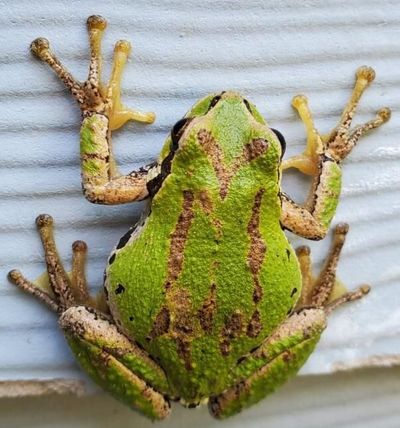Cool critters: Tiny frog, big noise – get ready for amphibian mating season

A greenish frog slightly larger than a quarter and donning a black Zorro mask recently started begging female frogs to have sex.
Which means, ribbit season is about to erupt across the Inland Northwest.
Each winter, the Pacific treefrog nearly becomes a frogsicle. Now that it’s late March, the critters have thawed and hopped away from their leaf litter shelters.
And they’re ready to rip.
“The Pacific treefrog is the smallest but most commonly heard frog in Washington,” according to the Department of Fish and Wildlife. What’s more, April through May is the amphibian’s peak mating season in our region, the agency says.
Chances are, you’ve already heard some scattered callers at dark. As the weather turns warmer, however, hundreds more will join in to produce a raucous nighttime chorus.
And you don’t need to live near a lake or pond to hear them, said Charles Peterson, professor emeritus of herpetology at Idaho State University. A standing body of water in a field, road ditch or park works just fine for treefrogs to breed, he added.
“We’re entering the time of year when many treefrog males have the urge to mate,” Peterson said. “Each one will loudly advertise to females that he alone is the special one.”
Ribbit-ribbit.
The iconic call is often used in movies as nighttime background noise. Consequently, many people think it’s the only sound that frogs make. In reality, of the more than 7,000 frog species throughout the world, only a small handful croak “ribbit.” Some frog species chirp. Others squeak or whistle. And still others twang like a banjo string or even oink.
“If you’re watching a movie that’s set outdoors in Africa and there’s ribbiting going on in the background, that’s not an accurate portrayal,” Peterson said.
But the Pacific treefrog that’s been Washington’s official state amphibian since 2007?
“It certainly does go ribbit,” he explained.
Also, just because it’s called the Pacific treefrog doesn’t mean it lives in trees. Although large, sticky pads on their feet enable them to climb trees, they spend most of their time on the ground, according to “A brief guide to frogs of the Pacific Northwest.”
And one final thing. Scientists have found that overly-aggressive male treefrogs can turn off females in a big way. But instead of asserting, “Not tonight, I have a headache,” females sometimes employ a bolder strategy: They fake being dead.
Several studies, including one published in the journal Royal Society Open Science, have documented female frogs going stiff and motionless to avoid mating. Playing dead, scientifically called tonic immobility, is sometimes used in the animal kingdom to avoid predators. But to avoid sex? That’s rare, according to research.
Presumably, her goal is to make the male pivot to another female frog. As for that female? Perhaps she’ll just give him a fake phone number and move on.